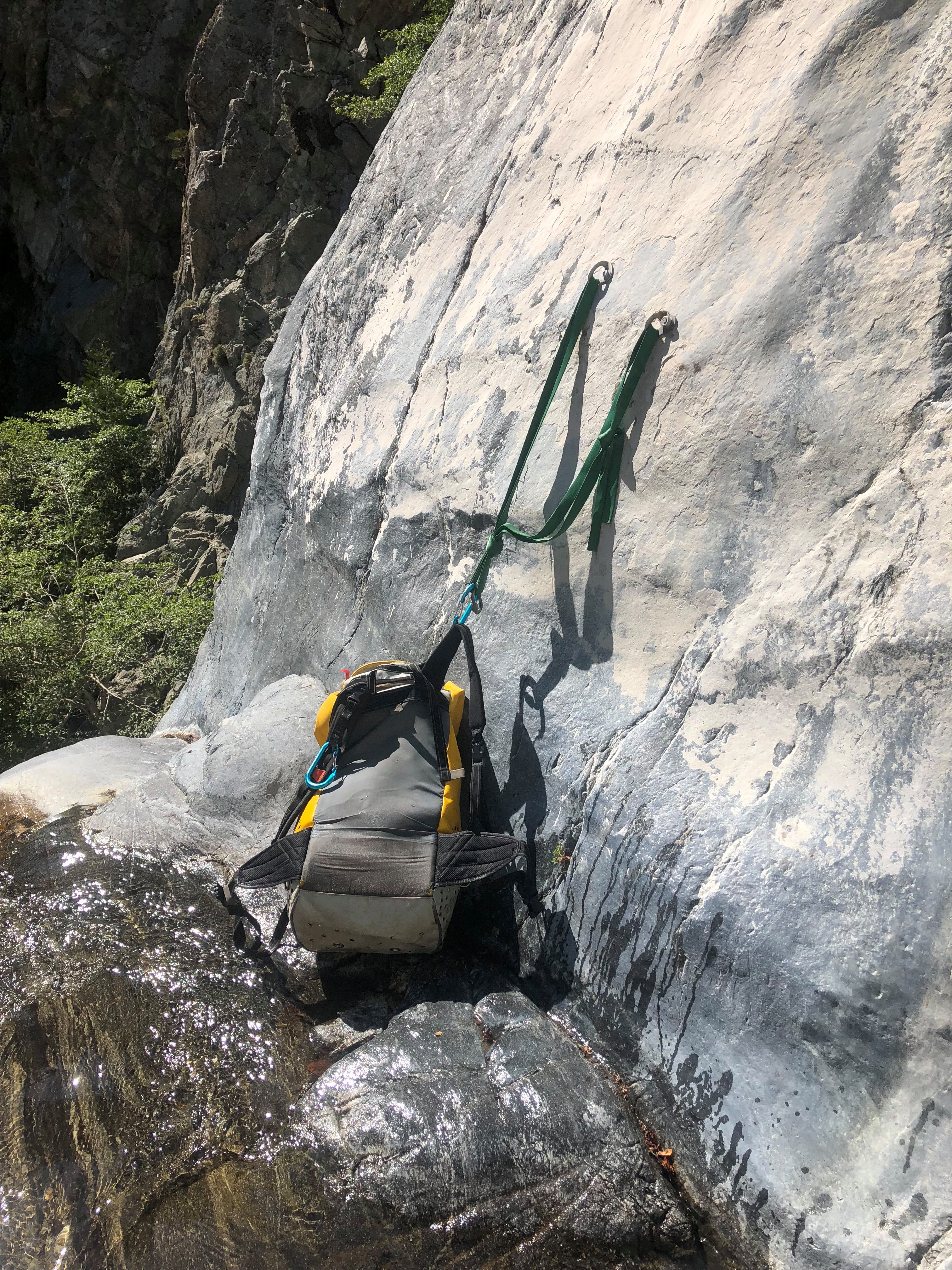Date of Event: 5/27/2019
Canyon involved: Middle Fork Lytle Creek
Region: San Gabriel Mtns, Southern California
Country: United States
Submitted by: Eileen Beall
Source: eye witness self-report
Injury: Laceration, Concussion, Head Trauma, Fracture, Hypothermia
Cause: Slip, Fall, No Fall Protection
Description of Event: On May 27th, 2019 a group of 3 canyoneers consisting of Eileen, Justin, and Becca descended the Middle Fork of Lytle Creek, a granite canyon in the San Gabriels. Although rain had been present in the area the day before, water flow did not appear hazardous and all members of the group were very comfortable with the conditions in the canyon. The weather was beautiful and by many standards the conditions were ideal. Aside from fashioning a natural anchor at the top of the 2nd rappel, the canyon was descended in typical fashion.
The incident occurred in the pothole between the 3rd and 4th rappels. The canyon left side of this pothole features a substantial ledge that gives way to the drainage on canyon right. This drainage features a narrow chute roughly waist-deep that flattens quickly to about 6 inches deep toward the lip. The anchor for the 4th drop is directly above this chute, and accessing it requires stepping directly into the watercourse. The drop is approximated at 80′.
In the conditions that day, the pothole was deep enough in sections to swim. Justin descended first, swam the pothole and climbed safely onto the ledge. Becca descended next and safely joined him on the dry ledge. As Eileen descended the rope, Justin and Becca had a conversation about the next drop and it was decided that Becca would set the next anchor once the rope was ready. Eileen was getting off rappel, and Justin went back into the pothole to start pulling the rope. Unseen by the others, Becca approached the anchor, stepping into the watercourse and slipping. Eileen looked over just in time to see her disappear, and shouted to Justin. Justin finished the pull down and dragged the rope to the ledge (the rope was not to be bagged due to the close proximity of the two drops). As the rope was being flaked to set the anchor, Eileen spotted Becca on the ground and observed that she was moving.
Justin cautiously stepped into the chute and clipped into the anchor and was able to safely set the rappel. In crossing this chute, both Justin and Eileen encountered a swift enough current that required awareness and concentration. In addition to the current, it seemed that there was the possible presence of algae that lent itself to very poor traction for this exposed maneuver. It is assumed that these conditions caused Becca to lose traction as she approached the anchor.
Justin descended to Becca and found her very badly hurt, but conscious. Basic first aid was administered by Justin and was continued by Eileen after she descended. It was quickly decided that Justin would go for help, and Eileen would stay with Becca. Justin rappelled the last drop, and proceeded down canyon. Eileen treated Becca’s legs and head to stem blood loss, and kept her awake and as warm as possible in the unavoidable spray from the falls.
Miraculously, help was found a short distance down canyon from a family who was camping for the weekend. Justin and 2 members of the family scrambled to a ridge above where Becca and Eileen were, and activated a SPOT beacon. After that, one of the family members ran back to the trailhead as a contingency. Another family member provided blankets and an additional first aid kit which were lowered by rope.
A helicopter appeared after an approximate 3 hour wait and Becca was safely airlifted to a local hospital. She arrived in critical condition, hypothermic at 94F with blood loss and multiple fractures. Her helmet almost certainly prevented a more severe head injury. Justin and Eileen safely made it out of the canyon, and Becca is mending well at the hospital. A huge thanks to the family who helped, and the San Bernardino Search and Rescue who safely got her to the hospital.
– report compiled by Justin and Eileen
Analysis: We strongly urge protecting access to this anchor. As the ledge offers no suitable protection, one solution is to have each person stay on rappel until clipping in to the next anchor.
More generally – plan ahead, particularly when setting and descending multistage rappels. Be alert and constantly assess risk as you proceed. Do not rely on beta or other group members to identify hazards. That said – if you see a hazard, alert your group members.
Assume all watercourses are slippery, and potentially forceful when flowing. Algae or slippery surfaces may not always be visible. Current will have a much greater effect on those of lower body weight.
Before approaching an anchor, always consider whether fall protection should be used to access it. In general, access to any anchor presenting a fall risk should be protected.
An emergency tarp would have reduced the effects of hypothermia. Be sure to insulate the entire body from the ground.

May 27, 2019: Lytle Creek, above the first rappel.

May 27, 2019: Becca Rogers on second rappel

May 27, 2019: Justin Pugh on second rappel (closeup of first stage)

July 13, 2018: anchor station for fourth rappel

July 13, 2018: view looking down fourth rappel